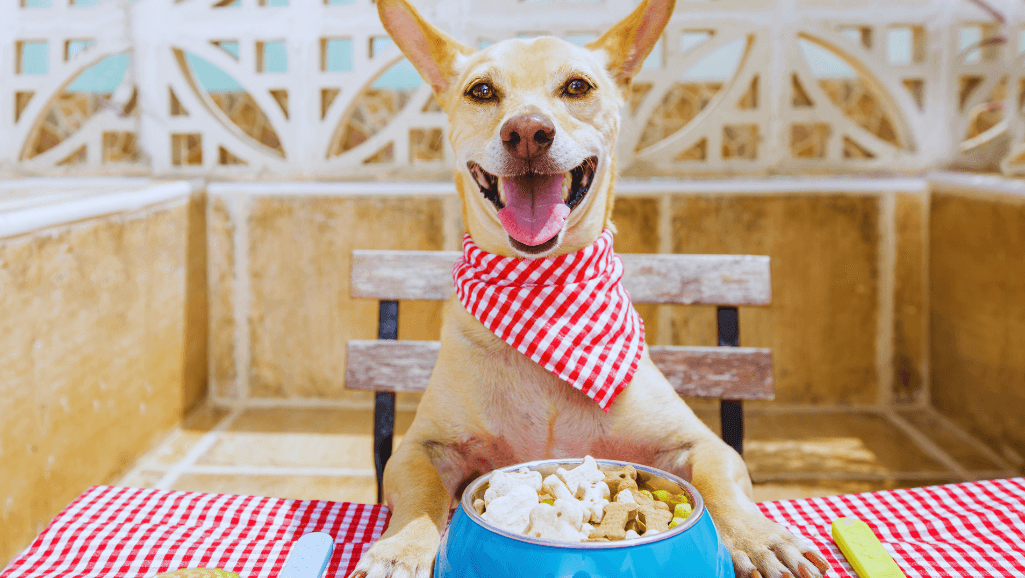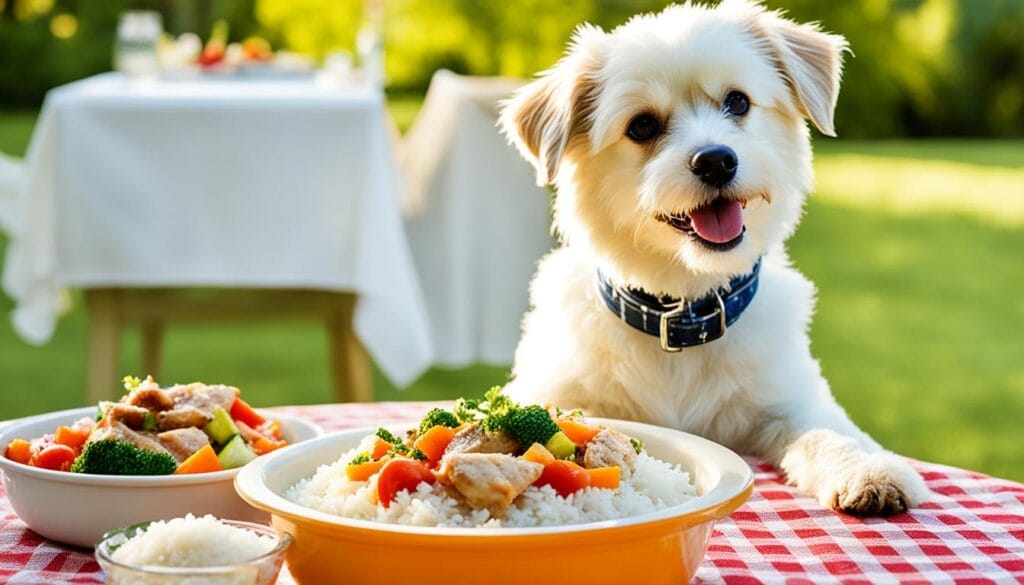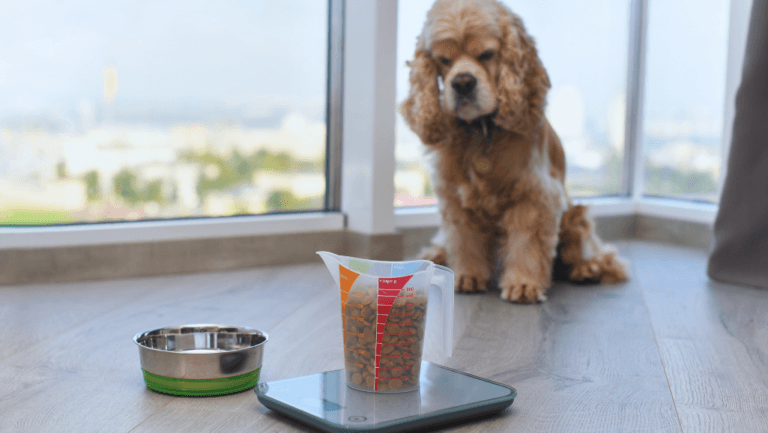Rice is popular in dog diets because it’s easy on their stomachs and very flexible. It’s great for dogs with tummy problems because it has little fiber. If your dog is sick, white rice can help make their stools firmer. Dr. Steve Weinberg suggests using white rice for dogs with diarrhea because it helps bind their stools.
While rice is good for homemade meals, it’s important to use it in small amounts. It shouldn’t be the main part of what your dog eats every day. Also, make sure it’s plain without any spices that could hurt your dog’s stomach or be toxic. Always talk to your vet before giving your dog a new food just to be safe.
For more tips, check out Purina’s guide on feeding rice to dogs.
Key Takeaways
- can dogs eat rice.
- Brown rice has more vitamins and fiber than white rice.
- White rice is good for dogs with stomach issues because it’s mild.
- Basmati rice is okay for dogs as a treat if it’s cooked simply.
- Dogs can have rice, but it shouldn’t be all they eat in a day.
- White rice can affect a dog’s blood sugar more than brown rice.
Nutritional Benefits of Rice for Dogs
Rice brings a lot to a dog’s diet if cooked well. It has key nutrients that can boost a dog’s well-being. Dog owners can learn about the advantages of adding rice. We’ll talk about the nutrients it has, how it helps the stomach, and why it’s good for dogs’ health.
Essential Nutrients
White rice is full of vitamins and minerals dogs need. It gives them magnesium, phosphorus, and vitamin B, all great for their health. Brown rice is even better because it keeps the bran. This makes it have more fiber and vitamins. In fact, brown rice has 48% of the needed daily manganese. White rice, in comparison, only has 13%. This shows that brown rice is super for a dog’s diet.
Digestive Health
White rice is perfect for dogs that have tummy troubles. It’s plain and easy to digest, which helps their stomachs. Brown rice, with more nutrients, is good for digestion too. It has a lot of fiber that keeps things moving in their gut and stops constipation.
Low in Fat and Sodium
Rice is low in fat and salt, a big plus for many dogs. It’s great for those watching their weight or on special diets. Since rice should be only a small part of their food, it’s a good snack. It gives dogs energy without the bad things from fatty or salty food. This way, dogs get what they need with no extra calories.
Can Dogs Eat Rice?
Yes, dogs can enjoy eating rice and it’s good for them. *White rice* is a top pick for dogs with tummy issues because it’s easy to digest. It also helps keep their stool solid. Both white and brown rice offer minerals and vitamins that are vital for a dog’s health.
Rice must be offered plain and cooked through. Don’t season it or add butter, as these are bad for dogs. Jasmine and basmati rice are fine too. They’re easy on a dog’s digestive system and perfect for simple meals.
Remember, keep rice in a dog’s diet to a small portion. About 10% of the food should be rice, and the rest balanced *healthy dog food*. The amount of rice you give should match the dog’s size.
- Extra-small dog: 1-2 tablespoons
- Small dog: 2-3 tablespoons
- Medium dog: ¼ cup
- Large dog: ⅓ cup
- Extra-large dog: ½ cup
Healthy dog food needs a mix of ingredients for full nutrition. Rice is a good add-on, not a meal by itself. With these tips, you can spoil your dog with a nutritious and delicious rice treat.
White Rice vs. Brown Rice: What’s Best for Your Dog?
Choosing the right food for dogs means looking at white rice and brown rice closely. Both kinds of rice have different effects on your dog’s health and digestion. It’s smart to know the good points of each to pick what’s best for your pet.
| Attribute | White Rice | Brown Rice |
|---|---|---|
| Ease of Digestion | Highly Digestible – Ideal for dogs with gastrointestinal issues | More challenging to digest due to the seed coat |
| Fiber Content | Low | High – Helps regulate bowel movements |
| Taste | Neutral and mild, generally appealing | Slightly bitter, though more nutritious |
| Consistency | Stable and consistent in texture and flavor | May vary in texture and flavor |
| Mineral Composition | Smaller and stable, reducing risks like brown stains in white-coated pets | Nutritionally dense with essential nutrients like B vitamins, calcium, and antioxidants |
| Protein and Starch | Lower in protein, higher in starch | Higher in protein, lower in starch, and gluten-free |
| Glycemic Index | High – May cause blood sugar spikes in diabetic dogs | Lower, better for maintaining stable blood sugar levels |
To keep your dogs healthy, think about what each rice type does for them. Also, talk to a vet to know the best choice for your dog. White rice is good for dogs with stomach problems. Brown rice is rich in nutrients, making it great for a balanced dog diet.
How Much Rice Should You Feed Your Dog?
Moderation is key when adding rice to your dog’s meals. It should be around 20-25% of their daily food. Commercial dog foods already contain enough carbohydrates. It’s important not to overdo white rice, which can lead to health issues like quick spikes in blood sugar and weight gain.
Moderation is Key
It’s critical to feed your dog rice in moderation. Rice should make up a small part of their meals, alongside proteins and veggies. According to the experts, treats such as rice should only be 10% of what your dog eats. The rest should be balanced, nutritious food.
Avoid Overfeeding
While rice is generally safe for dogs, too much can cause problems. How much rice to give depends on your dog’s weight:
- Extra-small dog (2–20 pounds) = 1–2 tablespoons
- Small dog (21–30 pounds) = 2–3 tablespoons
- Medium dog (31–50 pounds) = ¼ cup
- Large dog (51–90 pounds) = ⅓ cup
- Extra-large dog (91+ pounds) = ½ cup
White rice is gentle on upset stomachs but can cause blood sugar spikes and weight issues if not managed well.
Getting rice into your dog’s diet safely means knowing what they need. Talk to your vet. They can help keep rice a good part of your dog’s diet.
How to Prepare Rice for Dogs
When making rice for dogs, keep it simple. Cook the rice with just plain water. Don’t add any seasonings or spices. This keeps the food safe and healthy for your furry friend. Salt and other additives are bad for them.
| Step | Description |
|---|---|
| 1. Rinse Rice | Thoroughly rinse the rice until the water runs clear to reduce arsenic levels. |
| 2. Boil Rice | Use a 1 part rice to 3 parts water ratio. Boil until the rice is soft but not too mushy. This is easier for your dog to digest. To be sure, use the pinch test. |
| 3. No Additives | Make sure to add no seasonings, oils, or butter. Keep the rice plain and healthy for your dog. |
| 4. Appropriate Portions | Give your dog 1/4 cup of cooked rice for every 10 pounds of body weight. Always check with a vet for accurate amounts. |
Rice should be a small part of your dog’s daily calories, about 10-15%. White rice is best for dogs with kidney issues. It’s low in phosphorus and has a lot of manganese. Boil the rice in a 3:1 water-to-rice ratio. This makes it gentler on your dog’s stomach and better for their nutrition.
For dogs with tummy trouble, veterinarians suggest chicken and rice. Use one-third meat and two-thirds rice. This mix is easy to digest and provides needed nutrients. Remember, don’t use any seasonings. This keeps your homemade food healthy for your dog.
Potential Risks of Feeding Rice to Dogs
Rice can add good stuff to your dog’s food. Just remember, it should only be a small part. This helps avoid health problems.
Blood Sugar Levels
White rice can quickly raise blood sugar. This is not good for dogs with diabetes. Brown rice is better, but still watch how much your dog eats.
Weight Gain
Rice has a lot of carbs. Too much can make your dog gain weight. It’s key to mix rice with protein. This keeps their diet balanced and prevents obesity.
Constipation
Some dogs might have trouble if they eat too much rice. It can make them constipated. Always mix in other healthy food to avoid issues. Keep an eye on your dog’s tummy when you change their diet.
Rice can be good for dogs with the right care. Add it carefully to your dog’s meals. For more safe food tips for dogs, visit this rice guide.
Types of Rice Suitable for Dogs
It’s key to pick the right rice for your dog. Understanding the benefits of each type is important. White, brown, basmati, jasmine, and wild rice are all good if cooked plain.
White basmati rice helps dogs with tummy troubles because it’s simple. Brown rice keeps more nutrients but can be tough on some dogs’ stomachs. So, if your dog has tummy issues, white rice might be better.
Rice should just be a part of your dog’s meals. It must be cooked without any extras. Stay away from fried rice because it often has salt and spices that are bad for dogs.
| Type of Rice | Nutritional Value | Digestibility | Best For |
|---|---|---|---|
| White Rice | Lower in nutritional value | High | Dogs with gastrointestinal issues |
| Brown Rice | Higher nutritional content | Moderate | Dogs needing more fiber |
| Basmati Rice | Moderate nutritional value | High | Dogs with sensitive stomachs |
| Jasmine Rice | Similar to white rice | High | General consumption |
Choosing the right rice for your dog depends on its health and diet. Always talk to your vet. They can help you pick the best rice for your dog.
Combining Rice with Other Foods
Adding rice to your dog’s meals brings lots of nutrition. It’s best to mix it with lean meats and veggies. This makes for a well-rounded, homemade meal.
Pairing with Lean Protein
Rice goes well with lean meats like chicken or fish. A good mix for a healthy dog’s meal is two cups of rice and one of chicken. This boosts the meal’s protein, important for your dog’s body to grow and heal.
Adding Vegetables
Vegetables add more vitamins and fiber to rice-based diets. For a balanced meal, use a feeding calculator to check amounts. Carrots, green beans, and peas make great choices. They not only add important nutrients but also help digestion.
| Dog Size | Cooked Rice | Scrambled Eggs | Frequency |
|---|---|---|---|
| Small (5–10 lbs) | 1–3 tbsp | 1/2 | 2–3x per week |
| Medium (11–25 lbs) | 3–5 tbsp | 1 | 2–3x per week |
| Large (26–50 lbs) | 1/2–1 cup | 1–2 | 2–3x per week |
| Extra Large (51+ lbs) | 1–2 cups | 2–3 | 2–3x per week |
To avoid tummy trouble, feed rice and chicken in small, frequent meals. Dr. Dan Su, a vet nutritionist, says a balanced chicken and rice diet is good for dogs of all ages. Yet, always talk to your vet to get the best food advice. Remember, rice should be part of a diverse, healthy diet.
Conclusion
Adding rice to your dog’s food can bring many health perks. It includes vital minerals and vitamins, and aids their digestion. Both white and brown rice are good choices for dogs. They offer different nutritional boosts.
White rice has a lot of carbs. It can help dogs with tummy troubles by making their poop more solid. In comparison, brown rice has more protein and fiber. This makes it a rich choice, with benefits for managing blood sugar.
But, it’s key to feed rice the right way, and not too much. Too many servings of white rice can lead to constipation and high blood sugar. Eating too much rice, in general, can build up harmful arsenic. It can also cause allergies, like itching or tummy upset. When cooking, avoid spices and choose organic rice to dodge pesticides.
For a well-rounded meal, combine rice with lean meats like chicken or seafood. Add in veggies such as carrots or spinach. This makes for a healthy dish. Beware of foods that can harm dogs, like garlic, onion, or grapes. Always talk to your vet before changing your dog’s diet. Make sure it’s balanced and good for their health. Learn more about rice and dogs with this can dogs eat rice guide.

























